AD FILMS / TVC
Ad films are the most noticeable way of reaching the target audience. Innovative Media as one of the creative Ad film agency in Delhi. We promises to make remarkable Ad films for its clients. We are an Ad film maker in Delhi/NCR. Also we work with other established and renowned Ad film makers.

An ad film, also known as a commercial or TV commercial, is a short video that promotes a product, service, or brand. Ad films are a key part of advertising campaigns and can be used across many media platforms, including television, cinema, and digital channels.
An ad shoot is where creativity meets marketing. It’s the process of producing high-quality visual content—videos or photos—that tell your brand’s story in a compelling and engaging way. Whether it’s for a television commercial, social media ad, or product promotion, the right ad shoot can make all the difference in grabbing your audience’s attention and driving results.

Our ad shoot services help bring your vision to life. We create dynamic and visually stunning advertisements that resonate with your target market. From conceptualizing the storyline to executing a flawless shoot, we handle everything to ensure your brand gets noticed.

Here are some characteristics of ad films:
- Length
Ad films are usually between 10 and 60 seconds long.
- Message
Ad films should have a clear and compelling message that explains what makes the product special and why customers should buy it.
- Visuals and sound
Ad films use visuals and sound to set the tone and make the ad more memorable.
- Genre
Ad films can come in different genres, such as witty, emotional, or motivating.
- Production
Ad films can be shot on location or in a studio, and the production process can take weeks or months.
Ad films can be a powerful tool for brands to express themselves and reach a wider audience. They can help build trust, increase profitability, and attract new customers.
PLATFORMS FOR AD FILMS

BENEFITS
Ad films can benefit a business in many ways, including:
Benefits of Having Us Shoot Your Ads
Why Choose Us for Your Ad Shoot?
- 1. Creative Concept Development: We work closely with you to develop a unique concept that aligns with your brand’s message and goals, ensuring your ad stands out in a crowded market.
- 2. High-Quality Production: Our team of experienced directors, photographers, and videographers use state-of-the-art equipment to create visually striking ads that capture attention.
- 3. Versatile Shoot Options: Whether it’s a product-focused shoot, a lifestyle ad, or a full-scale commercial, we have the flexibility and expertise to produce the content you need.
- 4. Post-Production Excellence: After the shoot, we enhance the footage with expert editing, color grading, and sound design, ensuring your ad is polished to perfection.
- 5. Fast Turnaround: We understand that timing is crucial in advertising, so we ensure that your project is completed efficiently, without compromising on quality.
What’s Included in Our Ad Shoot Services?
TYPES
Here are some types of ad films:
- Promotional videos: A type of corporate video that promotes a business
- Brand videos: A type of corporate video that promotes a brand
- Product demonstration videos: A type of corporate video that demonstrates a product
- Training videos: A type of corporate video that provides training
- Testimonial videos: A type of corporate video that features testimonials
- Event coverage: A type of corporate video that covers an event
Six Types of Ad Films Your Brand Could Use
1) Branding Ad Films
 When launching a product in a competitive market, you must create and nurture an emotional connection with your target audience so that they remember you and can connect with your brand value.A great way to achieve this is through branding ad films that show your brand history, how it was conceived, and the true intention behind the brand. Briefly put: how your brand addresses the customers’ pain points and how it contributes to society as a whole.
When launching a product in a competitive market, you must create and nurture an emotional connection with your target audience so that they remember you and can connect with your brand value.A great way to achieve this is through branding ad films that show your brand history, how it was conceived, and the true intention behind the brand. Briefly put: how your brand addresses the customers’ pain points and how it contributes to society as a whole.
There are reputable ad filmmakers in Bangalore who can strategically curate such ad films to convey your brand message to your target audience.
2) Product Launch Ad Films
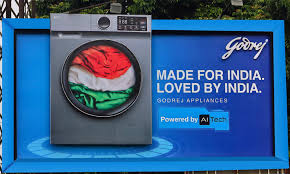 Did you know that 64% of consumers purchase only after watching a product video? Surprising right? That’s exactly how important product films are, as they help viewers understand your product in detail, what it does, and streamlines the buyer’s journey, moving many from the awareness stage to the consideration stage.
Did you know that 64% of consumers purchase only after watching a product video? Surprising right? That’s exactly how important product films are, as they help viewers understand your product in detail, what it does, and streamlines the buyer’s journey, moving many from the awareness stage to the consideration stage.
You can consider shooting ad films for your brand when new product launches happen and sharing them via social media, your brand’s YouTube channels, and email marketing to reach a larger audience and create awareness about your product.
The secret to having an engaging product launch video is by doing something outside the box that conveys how your product is different from your competitors.
3. Testimonial Video
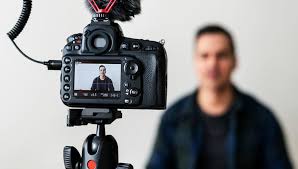 Testimonial videos are effective and go a long way in establishing brand authenticity and awareness. An ad filmmaking that features your clients sharing their experience with your brand and how it benefited them will help you acquire positive ratings and prove helpful to customers looking for the products and services you offer.
Testimonial videos are effective and go a long way in establishing brand authenticity and awareness. An ad filmmaking that features your clients sharing their experience with your brand and how it benefited them will help you acquire positive ratings and prove helpful to customers looking for the products and services you offer.
Testimonial videos convey that you care about your customer’s journey and help others trust your brand enough to purchase or consider acquiring your services.
4. Process Ad Films
 Process ad films explain how to put together or use a product meaningfully while subtly promoting the product or service. If you want your customers to understand how your products can be used, then opting for ad filmmakers who curate process ad films is a great idea to advertise your brand.
Process ad films explain how to put together or use a product meaningfully while subtly promoting the product or service. If you want your customers to understand how your products can be used, then opting for ad filmmakers who curate process ad films is a great idea to advertise your brand.
Often, customers need clarification about the usage method and skip to the next available brand that deems fit when they don’t have a clear idea. Process advertisements? compensate for this knowledge gap in customers and augment a brand’s products to its target audience.
You can strongly advertise your product by sharing these ads on YouTube, social media, and your website blogs.
5. Advertisement Films for Social Media
 Social media has become an elixir for most brands as they continue to utilize the power of social media to the fullest to acquire new customers and increase brand awareness. An ad film for social media can help you advertise your brand products while preaching your brand value.
Social media has become an elixir for most brands as they continue to utilize the power of social media to the fullest to acquire new customers and increase brand awareness. An ad film for social media can help you advertise your brand products while preaching your brand value.
To create social media advertisement films that make a buzz, consult ad filmmaking companies who have been experts in the industry for a long time and know what’s trending to create social media videos that help your products reach the right audience.
6. Commercials
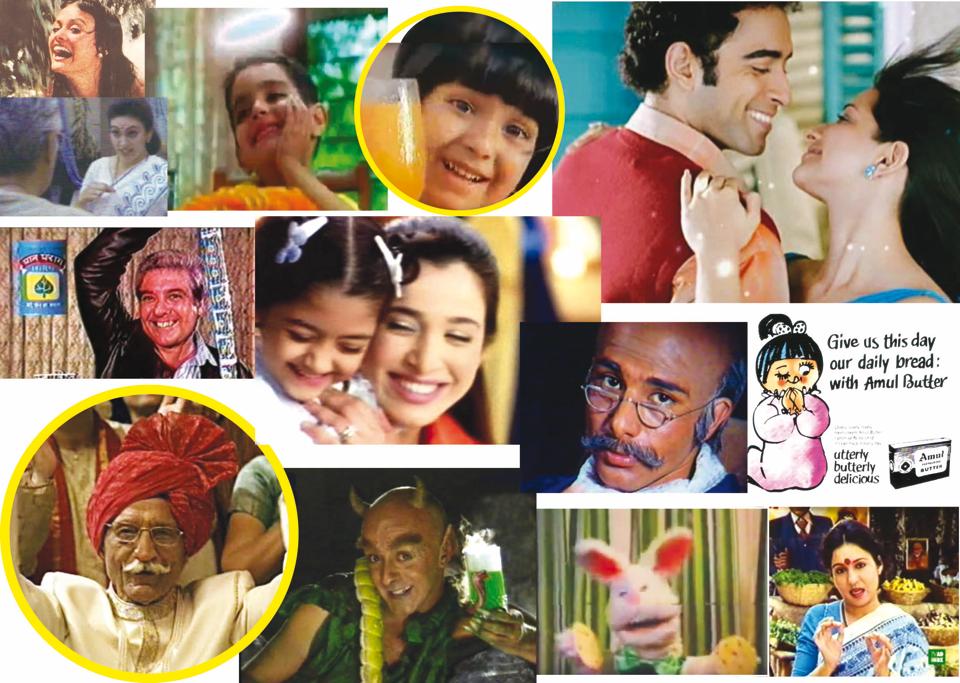 It’s no secret that effective commercials have always been game-changers in breathing life into a product and helping it maximize engagement. By consulting the best ad filmmakers in Bangalore, you can curate commercials that leave an impression on the viewers and increase your brand reach phenomenally.
It’s no secret that effective commercials have always been game-changers in breathing life into a product and helping it maximize engagement. By consulting the best ad filmmakers in Bangalore, you can curate commercials that leave an impression on the viewers and increase your brand reach phenomenally.
ELEMENTS
- Camera Equipment:
High-end professional cameras can range from a few thousand to lakhs of rupees. Additional costs may include lenses, lighting equipment, and accessories. Only a guy with a good camera can costs from 10,000 to Rs. 1,00,000 per day of the shoot. Equipments like high-end cameras cost a fair amount cost from Rs. 5,000-20,000 Rs per day of rent. Such cameras are capable to shoot 4K videos and more. High-end devices like drones start at a cost of 15,000 Rs. on per flight basis
- Idea and script
A script can add up to 10% of the production cost
- Shooting
Studio Rental and costs depend on the size, location, and amenities. Prices can vary significantly.
- Talent Fees:
Actors, models, and other talent may have varying fees based on their experience and popularity. For a commercial video one can always hire new faces as they are relatively more affordable..
- Crew Fees:
Hiring skilled professionals like directors, cinematographers, editors, and sound engineers will contribute to the overall cost.
- Props and Set Design:
Depending on the complexity of the ad, costs for props, set construction, and set decoration can add up.
- Post-Production:
Video editing, special effects, sound design, and color grading contribute to post-production costs. Post production specialized people working on high-end software like Adobe Premier Pro and Final Cut pro.
- Location Fees:
If shooting on location, there might be fees associated with permits, location scouting, and rental costs.
- Miscellaneous Expenses:
Miscellaneous costs may include transportation, meals for the crew, and other incidentals.
PROCESS

The Beginner’s Guide to Ad-Filmmaking production Process
Ad-film maker’s industry go hand in hand with digital marketing, since advertisement play a great impact on people, which companies want to target for marketing of products as well as services.
If the basics are known to the maker, it is possible to make ads in very less time and efforts. Have a look at the basics of ad-films for beginners:
Step 1: Making a brief
For briefing, we need to grab an information about some of the factors like potential buyers, marketing goal, where will the ads be shown, length of the video, type of ad, expenditure.
Step 2: Pre-Production
This stage involves
1. Planning of cast and characters, whatever maybe the type of advertise.
2. Location of the shoot,
3. Storyline
4. VFX to be used
This is the planning phase in which a production schedule is developed which is a detailed work plan of anything and everything.
Step 3: Video Production
The plan created in the previous phase is implemented in the Production stage. Video shooting is a time taking process as each shot is to be taken properly. Shooting equipments are required to be moved after every shot and therefore it is imperative that the film crew be allotted sufficient time to capture the best shot possible.
Step 4: Post Production
This is the final phase in creating the video, Post-Production involves editing of the captured scenes, adding graphics and animation, music and audio composition, giving voice-over, dubbing, color correction. Every part of the video is re-edited if it is not proper and fine-tuning is performed.
This guide serves as a starting point for ad film production beginners to understand the technicalities involved in this field.
Exploring the 5 Stages of Filmmaking
Exploring the five stages of filmmaking is essential for anyone interested in the industry, offering valuable insights into the complexities involved in realizing a film project. The process unfolds in five distinct stages, each playing a crucial role in transforming an idea into a compelling visual narrative. Let’s delve into the intricacies of these stages and unravel the magic that goes on behind the scenes.
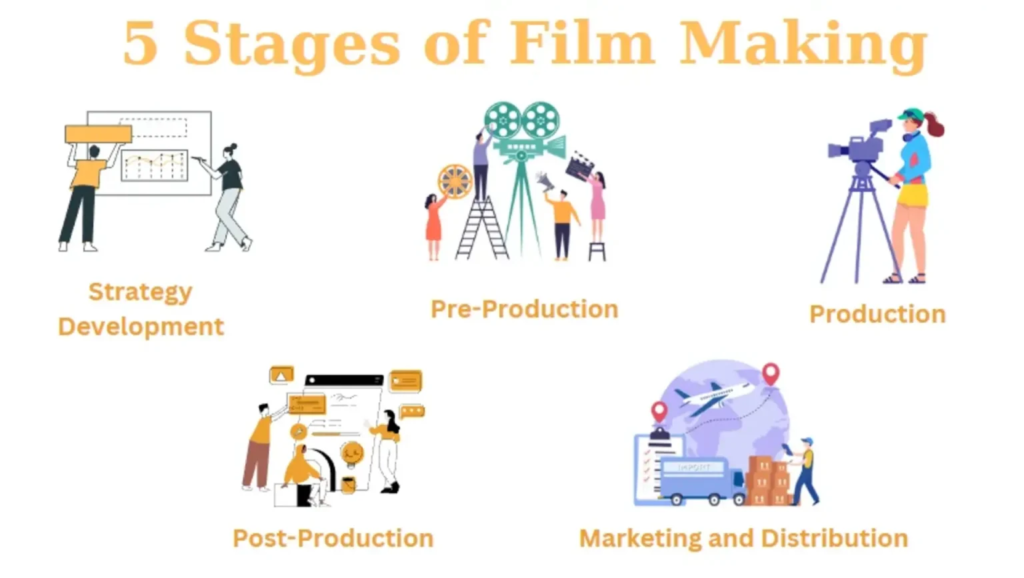
1. Development: The Birth of an Idea
The journey commences in the development stage, where a project producer gathers the seeds of an idea, often sourced from books, plays, or original concepts. This phase involves crafting the screenplay, creating storyboards, and preparing a synopsis to pitch the project for funding. A delicate dance between creativity and business development sets the foundation for the entire filmmaking process.
Intricate networking and meetings follow, especially in cinematic hubs, where producers seek potential financiers. The aim is to secure the necessary funds to breathe life into the envisioned project, paving the way for the subsequent stages.
2. Pre-Production: Crafting the Blueprint
With funding in hand, pre-production unfurls as a meticulous planning and preparation period. It encompasses a range of tasks, from casting and crew selection to location scouting, set design, and prop creation. Budgeting becomes a crucial tool, guiding the spending plan and prioritizing needs to ensure a smooth production.
Key players, including the director, producer, and assistant director, collaborate to create a detailed schedule and shot lists. Actors undergo rehearsals, and the production team gears up for the demanding shoot ahead. Pre-visualization techniques, such as storyboards and concept art, aid in determining the film’s visual aesthetics.
3. Production: Lights, Camera, Action!
Known as principal photography, the production stage is where the film is physically shot. The assistant director takes center stage, coordinating various teams simultaneously. Actors, having undergone extensive rehearsals, bring characters to life, while the production crew works tirelessly on the technical aspects of lighting, sound, and cinematography.
Despite meticulous planning, the unpredictability of Murphy’s Law hovers over every set, demanding adaptability and problem-solving skills. The director takes the creative helm, making decisions that shape the film’s visual narrative. The culmination of this stage marks the completion of the raw footage, ready for the transformative journey that lies ahead.
4. Post-Production: Crafting the Final Masterpiece
Post-production is the realm where the editor, often in collaboration with the director, weaves together the raw footage into a cohesive narrative. The process involves multiple stages, starting with the assembly cut, a rough sketch of the film’s structure. Subsequent phases, including the rough cut, fine cut, and picture lock, refine the edit, ensuring a seamless flow.
Simultaneously, other departments dive into their tasks: visual effects teams enhance the visual elements, sound designers orchestrate the film’s score, and color correction experts add the finishing touches. The result is a polished, final edit ready for the audience.
5. Marketing and Distribution: Bringing the Film to the World
In the realm of marketing, teasers, promotional posters, festival screenings, and social media become crucial tools to generate buzz for the film. Major production companies may secure exclusive deals with platforms for a lucrative release, while smaller productions might navigate multiple streaming platforms.
The distribution phase, once centered around physical copies, has evolved with the dominance of streaming services. Theatrical releases, television, Blu-ray, and streaming platforms provide diverse avenues for audiences to experience the film. The journey concludes with press interviews, red carpet premieres, and launch parties, marking the film’s introduction to the world.
Conclusion
Film production is a collaborative journey that transforms ideas into captivating visual narratives. The five stages—Development, Pre-Production, Production, Post-Production, and Marketing/Distribution—require meticulous planning and creativity. It begins with crafting the screenplay and securing funding, followed by detailed planning, shooting, and editing. Marketing generates buzz, and distribution ensures the film reaches diverse audiences. Each stage involves diverse professionals working together to create a polished masterpiece.
DETAILED PROCESS
Video production process typically takes a few weeks (3-8).
The production time depends on the ad film’s duration, its complexity, the flow of works, communication between both parties (or three parties if an Agency also takes part in the discussion), work load, etc.
Regardless of the deadline the process of ad video production stays the same and it’s divided into 8 steps.
1. Gathering materials (including Brief)

We initiate the process of making a film with precisely that. We need to understand the subject of your video inside-out. Therefore the client presents his or her vision (thanks to questions included in our Brief questions), and we learn what are the specifics of the client’s business.
- Film objectives,
- The film’s setting within the brand’s communicative strategy,
- An idea as to the design/style of the video,
- Graphic symbols,
- Selected music,
- Deadline (when does it have to be ready?),
- Estimated duration of the video,
- Etc.
After Brief we collect materials from the client. Typically: PowerPoint Presentations, flyers, website links etc. All the things that help us understand the subject of your video.
2. Creating a script

A well written scenario constitutes the key for creating a great explainer video.
Basing on information collected from the client we create an initial scenario outline. Due to the fact that we are from the outside we can notice those elements which are especially important for potential recipients. Remember that recipients usually do not possess such knowledge concerning the company as its employees, so it has to be presented to them in a clear manner.
When we agree with the client what should be presented on the factual level, our copywriters translate that message into an attractive story. Meaning de facto – the film’s scenario.
The scenario usually takes on the form of a story, which helps to keep the viewers’ attention. It’s consistent with the client’s guidelines regarding the movie’s style, characters, brand’s image etc. Next we send the scenario to the client who makes any potential corrections. After accepting the proposed contents we the scenario goes to the proofreader or native speaker who checks if there are any mistakes.
If everything is okay we proceed to the next stage of producing an explainer video.
Summing up, the scenario constitutes the voice/factual content (what we will hear in the film). And to a large extent it determines the final duration of the video. Our calculations show that usually there are circa 90-100 words in English for every minute of the video.
There is of course the possibility to include the entire scenario and film in the company’s wider marketing strategy. Then we take advantage of the client’s guidelines concerning the style in which the film should be made, what slogans to use, who is the main character, etc.
How should a scenario look like?
An often used, and recommended by us, model on which we base when making most of our films is the model of a character’s journey, used in most ancient myths and modern motion pictures, meaning:
- CHARACTER (we present the character – he may be tangible in the movie or enter in a dialogue with the recipients assuming that they are our characters)
- OBSTACLE (the character comes across an obstacle – we show it rather with humour and perfidy than in the style of fear)
- METHOD (the character finds a way to deal with the obstacle – it of course consists in our product/service about which we talk and which we present)
- CHANGE (we show the character after a change which happened within him or her thanks to our product/service, we present advantages, his or her happiness/relief/better life, etc.)
3. Creating a storyboard

At this stage the first real “outline” of the film is created because a storyboard constitutes a document which allows us to see how the movie is going to look like, frame by frame.
A storyboard includes specific phrases from the scenario accompanied by images. The scenario is divided into specific scenes with assigned images of particular film frames, voice over text, used props, and remarks concerning production and editing. Below you can find example elements from storyboards, which we’ve really used when making films for our clients:


At this stage we usually select the professional voice actor who is going to grasp the viewer’s attention and evoke the right emotions. We apply the voice, tempo and acting to the movie’s subject and goals. We can provide voice-overs in most of the world’s languages.
4. Storyboard approval

This is the most important element in the entire process of film production. Why? Our films are created “live” (are shot on a real film set at our studio) just as real motion pictures.
Just imagine that for example after shooting an entire sequence of scenes, when the production manager sees the recorded material he states “You know what, let’s have one man in this scene and not two, and include fourteen women (including one Chinese woman), shoot it not from above but from the point of view of a frog, and we should really shoot the scene in London at dawn and not at dusk in Berlin”…
In practice, this would mean that everything has to be recorded once again… Nothing can be “fixed”. So actors (who are often already handling other businesses) have to be called again, or perhaps a completely new casting must be held once more, props must be prepared, a new letter to the City Hall regarding using public space must be written…
The case is similar when it comes to our films. The illustrator has recorded the film, leaves the set, and the film goes to editing. Any changes require to call for the illustrator and engage the editor.
Summing up: accepting the storyboard is key. After accepting the storyboard the client does not introduce any changes, even the smallest ones.
Changes made after accepting the storyboard result both in an increase of costs as well as extending the production time.
5. Preparing props and doing the conceptual work

When we already know what are we making and how, then the props are prepared – both paper ones, handmade by us, as well as the “real” ones which have to be found and purchased in accordance with the storyboard.
Cartoonist looks for the best way to transform the storyboard’s plot into a great movie. Apart from the props he is i.a. making first sketches, testing sizes of the pictures, choosing the appropriate colours from over 200 markers.
6. Film set

We usually reserve 2-5 working days for the film set.
The films are recorded in high quality with an HD camera. The illustrator can take advantage of more than 200 marker colors and countless numbers of paper materials. Furthermore, the illustrator is also supported by the production manager who helps to execute the more complex scenes.
Usually 40 – 60 minutes of recordings, which take 60 – 100 GB of space, are created when making a film with the duration of 1 – 3 minutes.
7. Editing

Editing always starts with correcting colors during which we make the recorded colors as close to natural ones as possible.
Then the video material is cut into portions with their speed increased at more than ten times. Any unnecessary hand movements and failed scenes are being deleted. One minute of recording is usually “composed” of a few hundred short fragments.
The pace and duration of each one is synchronized by hand with the words spoken by the voice actor in order for the image and writing to perfectly correspond with the voice over. That is why editing one minute of video usually takes a few hours of constant work.
Any special effects or stop motion animations, which cannot be done using traditional methods, are created and added during the editing.
8. Implementing final corrections

It happens very rarely that there aren’t any.
They are usually limited to minor changes in the pace of particular scenes. If the changes exceed the previously agreed scenario and storyboard then we have to record the scenes anew, which rarely allows to meet the initial deadline and budget.
That is why point 4, accepting the storyboard, is so important.
Summary

The process described above may seem complex. However we take that entire load on our shoulders because we execute films from start to finish. The client usually provides us only with feedback at the scenario and storyboard stages, so that we are certain that the film is going to look the way it has to.
THE PROCESS OF GETTING YOUR AD FILM DONE
Innovative Media
Success Redefined
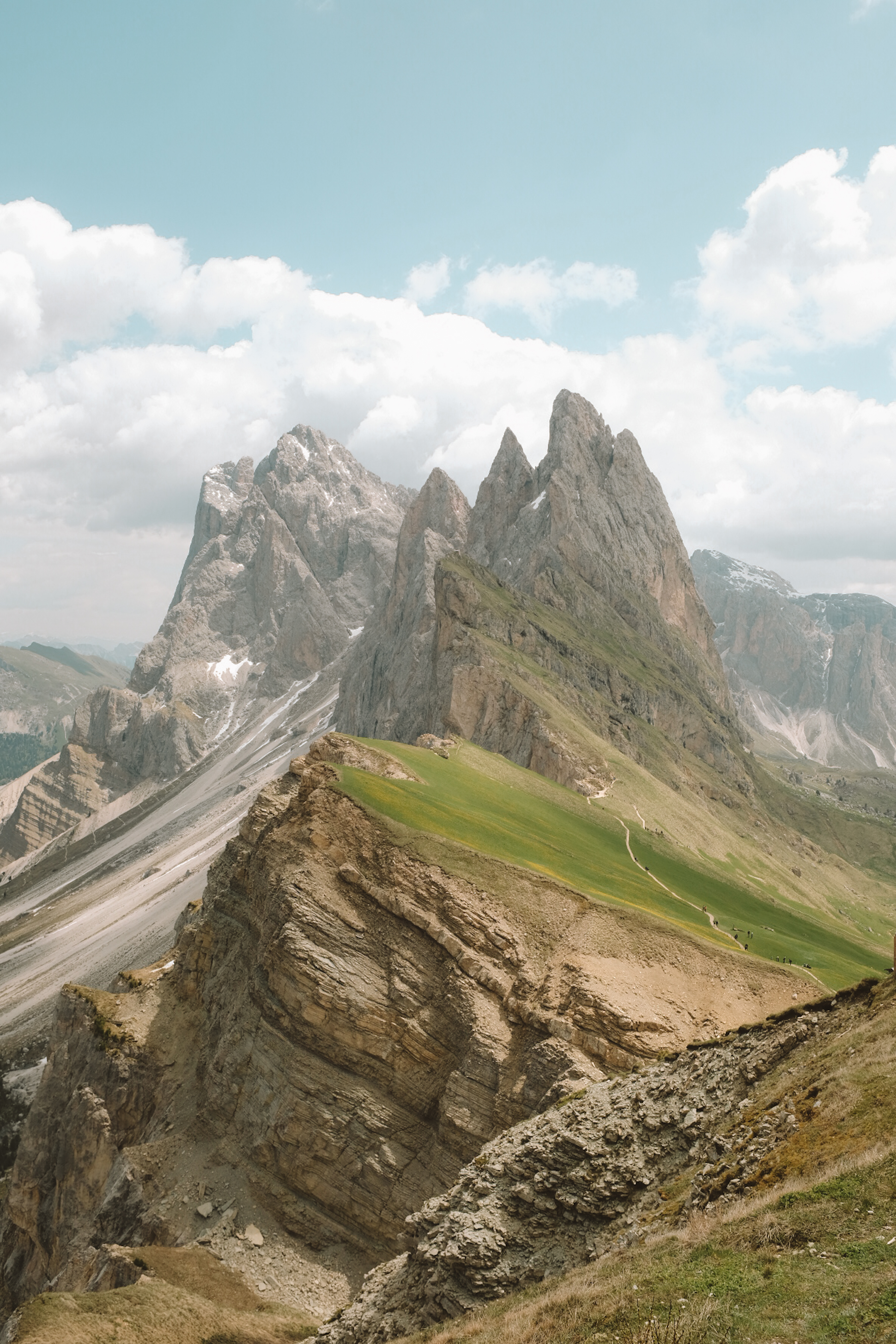
COSTINGS OF AD – FILMS
Basic
- Camera Equipment:
High-end professional cameras can range from a few thousand to Lakhs of rupees. Additional costs may include lenses, lighting equipment, and accessories. Only a guy with a good camera costs from 10,000 to Rs. 1,00,000 per day of the shoot. Equipment like high-end cameras cost a fair amount cost from Rs. 5,000-20,000 Rs per day of rent. Such cameras are capable to shoot 4K videos and more. High-end devices like drones start at a cost of 15,000 Rs. on per flight basis
- Idea and script
A script can add up to 10% of the production cost which is roughly Rs. 6,000-12,000
- Shooting
Studio Rental and costs depend on the size, location, and amenities. Prices can vary significantly.
- Talent Fees:
Actors, models, and other talent may have varying fees based on their experience and popularity. For a commercial video one can always hire new faces as they are relatively more affordable. They might agree to work for Rs.10,000 to 25,000 Rs.
- Crew Fees:
Hiring skilled professionals like directors, cinematographers, editors, and sound engineers will contribute to the overall cost.
- Props and Set Design:
Depending on the complexity of the ad, costs for props, set construction, and set decoration can add up.
- Post-Production:
Video editing, special effects, sound design, and color grading contribute to post-production costs. Post production specialized people working on high-end software like Adobe Premier Pro and Final Cut can charge from Rs.2,000 – 10,000 per hour
- Location Fees:
If shooting on location, there might be fees associated with permits, location scouting, and rental costs.
- Miscellaneous Expenses:
Miscellaneous costs may include transportation, meals for the crew, and other incidentals.
Our Pricing for Ad Shoots
We offer competitive rates based on the complexity and scope of the project:
Basic Ad Shoot: For simple, straightforward shoots, like product advertisements or small-scale promos (up to 1-minute duration). Price: ₹10,000 – ₹20,000 Appx
Advanced Ad Shoot: For mid-range productions, including lifestyle ads or multi-product shoots with more complex setups (1-3 minute duration).Price: ₹20,000 – ₹40,000 Appx
Premium Ad Shoot: Full-scale productions for TV or digital campaigns, involving actors, multiple locations, and detailed post-production work (3-5 minute duration).Price: ₹40,000 – ₹3,00,000 Appx
Customized Package: Need something unique? We offer fully customizable packages for larger campaigns or special requirements. Price: Contact us for a quote.
OTHER CHARGES
- Costs for creating specialised high-quality images, cartoons, videos, and graphics etc or hiring a specialised freelancer will be extra.
- GST 18% will be extra.
Note: For any type of contract agreement and advance is mandatory as well as purchase order (PO) in some cases. We do not work without any of these.